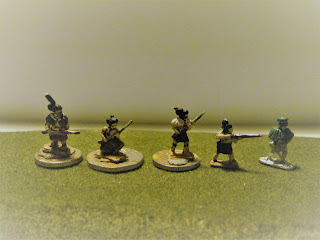I have an Indian city that I made a couple of years
ago. I wanted to try out some street
fighting in the Mutiny using Piquet Field of Battle but other projects
intervened. Anyhow here’s the city.
British Generals hated street fighting as most of the military
advantages they possessed tended to evaporate within the confined quarters of a
city. Command and control became pretty
difficult, discipline was wont to collapse and the advantages in firepower were
minimised in building to building close fighting. For the officers and men, the promise of
spectacular loot seems to have compensated for the increased danger.
That said it was undoubtedly a traumatic experience and
whole formations of British soldiers would become immobile through drink should
they come across large stores of alcohol.
When this happened, the officers learned to hold their tongues. The problem was common enough for Senior
Officers to speculate that leaving large caches of alcohol was an Indian
tactic.
I want to reflect this within
the game- a simple roll of two dice will determine on a double if a building
has alcohol and the number how many turns the troops are incapacitated. A throw of double four, four turns of
defensive action only for example. This
will only apply to European troops.
The British auxiliary formations of Ghurkhas and Sikhs do
not seem to have indulged in the same behaviour. The Ghurkhas because they were too well
disciplined and the Sikhs because for them the Mutiny was an opportunity to
loot in a systemic fashion the former Moghul Empire that had once oppressed them. British officers did comment that the Sikhs were only there for the loot but without them little could be achieved. Also looting was deeply entrenched within the military system and we might say necessity found the sanction of custom and practice .
They were both very capable fighters but I’ll need to find
a mechanism to reflect the aims of the Sikhs. In actuality the Sikhs simply shared out the
loot on the spot giving their British officer an ample proportion. Sometimes the original owner was threatened
with death in order to reveal hidden treasure.
This took time so I’m going for any building taken by Sikhs means the
miss they next turn, save for defensive action, as they are busy.
For the Indian defenders, different issues need to be
considered. Some of the citizens
including women will decide to fight.
The rulers body guard or retinue will resist too. The Sepoys, artillery and Sowars will fight
too but only as individual units. Each
will answer only to their own commander.
I thought two British Brigades would be adequate to try this out. The General will be off table so the Brigadiers will operate separately though one
of them will have Seniority. Here’s how
they look as per Piquet.
Wilson's Brigade
Unit
|
Armament
|
Combat Die
|
Defence Die
|
Short Range
|
Medium Range
|
Long Range
|
Neil’s Blue Caps
|
Musket
|
D10
|
D6
|
0-2
|
3-4
|
5-6
|
Highlanders
|
Rifle
|
D12+1
|
D8
|
0-3
|
4-6
|
6-8
|
84th
|
Rifle
|
D10
|
D6
|
0-3
|
4-6
|
6-8
|
Sikhs
|
Musket
|
D12+1
|
D4
|
0-2
|
3-4
|
5-6
|
Arbuthnott's Brigade
Unit
|
Armament
|
Combat
Die
|
Defence
Die
|
Short
Range
|
Medium
Range
|
Long
Range
|
30th
|
Rifle
|
D10
|
D6
|
0-3
|
4-6
|
6-8
|
Sikhs
|
Musket
|
D10
|
D4
|
0-2
|
3-4
|
5-6
|
Ghurkha’s
|
Musket
|
D10
|
D6
|
0-2
|
3-4
|
5-6
|
Foot
Artillery
|
9lb
smoothbore
|
D12
|
D6
|
0-5
|
5-10
|
10-18
|
More soon, with further thoughts on how to play the Indian defenders.


















